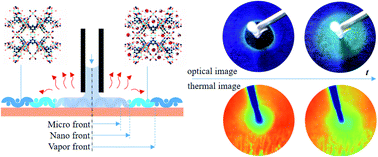A superhydrophilic metal–organic framework thin film for enhancing capillary-driven boiling heat transfer†
Abstract
Many engineering technologies such as electronic cooling and thermal desalination exemplify the enhancement of evaporation and boiling heat transfer by surface modification. Nevertheless, the core parameters of heat transfer such as critical heat flux and heat transfer coefficient are associated with surface wettability and morphology. Herein, for the first time, a metal–organic framework (MOF) film, viz. HKUST-1, was integrated into a metallic woven mesh (macroporous support) for enhancing liquid rewetting and capillary-driven evaporation and boiling heat transfer. Compared to bare copper mesh, this architecture was found to significantly increase the critical heat flux by 205% and the heat transfer coefficient by 90%. The complex coupled two-phase (liquid and gas) transport process involving capillary wicking, evaporation, adsorption and desorption were critically examined by analysing the dynamics of multiple interfaces during horizontal wicking. Relying upon visible colorimetric changes, HKUST-1 sustained on the copper woven mesh could expedite quantitative analysis of the coupled capillary evaporation process. In principle, this is primed to offer fundamental insights into the mechanisms of transport phenomena. Introduction of such previously unreported hierarchical porous structures could also potentially advance the state-of-the-art of passive thermal management technologies. In essence, a new route to elicit superhydrophilic surfaces emerges, paving new ways for understanding the intrinsic mechanisms of phase-change heat transfer.



 Please wait while we load your content...
Please wait while we load your content...